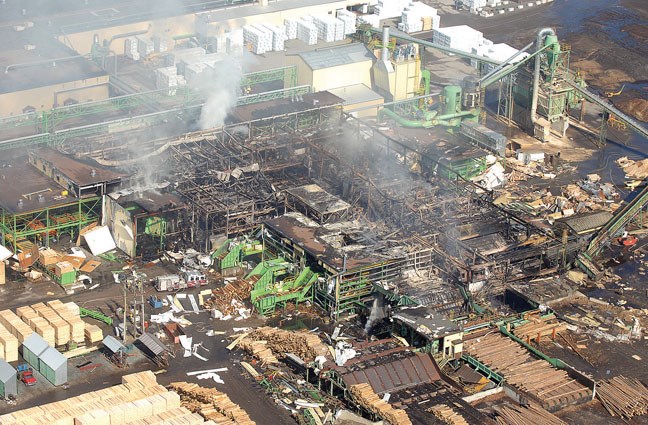A WorkSafe B.C.investigator took a coroner's inquest through his findings Tuesday into the explosion that destroyed the Lakeland Mills sawmill nearly three years ago, killing two workers and injuring more than 20 others.
Paul Orr, a supervisor in WorkSafe's investigation division, said the ignition source was traced to a fan on a gear reducer for a conveyor on the mill's basement floor and beneath the slasher deck.
He said it came loose and jammed into a fibreglass screen in the housing at the end of the gear reducer and, with the reducer's shaft still spinning at 1,750 revolutions per minute, friction was created to the point where the shaft had become hot enough to ignite sawdust in the area.
Orr said the initial explosion might not have happened right at the gear reducer but rather could have ignited saw dust in the air and continued to a spot where the dust was concentrated enough to cause the blast.
Lakeland Mills had been processing beetle killed pine which creates a particularly dry and fine dust that could remain in the air for some time before settling down on level areas, the inquest has heard.
Large headrig operator Glenn Roche and supervisor Al Little were killed in the blast. Another 21 Lakeland employees as well as a union representative and a human resources consultant were in the sawmill at the time of the April 23, 2012 disaster, many of them suffering serious injuries. Investigators concluded the initial blast occurred at 9:37 p.m.
In earlier testimony, Donald Zwozdesky, an electrician at Lakeland, disputed the finding that an overheated a gear reducer was the cause, saying he would have smelled something or heard a noise as he walked by just before the lunch hour horn had gone off at 9:30 p.m.
But Orr said that once the fan became jammed, it could have taken only a couple minutes for the reducer to heat up. "As soon as he walked past this could've come off," Orr said.
Orr described the explosion as a deflagration, which propagates through heat transfer and at less than the speed of sound. A detonation, in contrast, propagates through shock waves and at greater than the speed of sound.
Alluding to testimony from workers who were there, Orr said deflagrations are noted for initially making a "whoosh" sound. In dust-related explosions, Orr said a primary event sends out a pressure wave that lifts dust into the air and the secondary dust clouds are ignited.
Both Roche and Little died from severe burns. Investigators determined Roche, who had a habit of using compressed air to clean off the large headrig just after the lunch horn went, was in the area above the explosion and Little was in a computer room off to one side when the blast occurred.
At least two more employees narrowly escaped being killed, Orr indicated.
Had slasher saw operator Wayne Cleghorn still been in his booth rather than in a downstairs washroom at the time of the blast, "he probably would not have survived."
Curtis Ducharme, whose responsibility was to clean out debris beneath the large headrig over the lunch break was "right in the middle of the firestorm."
"The only reason that Curtis probably survived was probably because he was protected by the equipment," Orr said.
That Ducharme heard what sounded like a jet engine starting up was "the best description I've heard of deflagration in a long time," Orr said. "He was less than 30 feet away when this wood dust caught fire."
By the time the fireball had neared the mill's further reaches it had lost enough strength to allow workers near the southeast corner to duck a flashover.
And if not for a large amount of open area above operating floor, Orr said the damage could have been even worse because the explosion would have been further contained and not weakened as quickly.
Similarly, although the walls were not designed for explosion displacement, they blew out. Had they held, "there would have been a lot more damage," Orr said.
But Orr said a major fire at the large headrig on Jan. 19, 2012, when a column of flame leapt as much as 50 feet into the air, "could easily have been April 23 that day."
The only difference, said Orr, was that there was not enough containment. "As it was, we ended up with dust burning in the air," he said.
That event occurred the day before the dust-related blast at Babine Forest Products near Burns Lake killed two people and injured more than 20 others.
The inquest continues today at the Prince George courthouse, 9 a.m. start.



